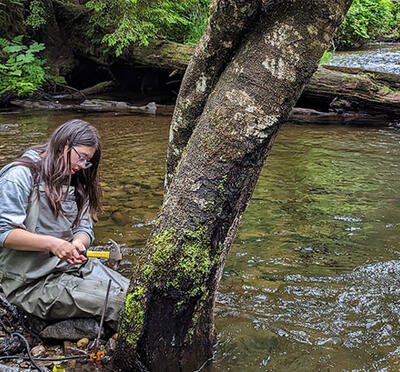What images pop up when you hear someone mention wind power and solar power? It’s a safe bet you’ll picture towering three bladed turbines, photovoltaic panels, or perhaps vast mirror arrays. But what do you see when you imagine the machinery used to harvest wave energy?
“We all know what wind and solar technologies look like, but there are five or six leading concepts for wave energy converters, and individual WEC designs vary dramatically,” said Bryson Robertson, associate professor of coastal and ocean engineering at Oregon State University and director of the Pacific Marine Energy Center, a consortium of universities dedicated to exploring the potential of marine energy.
Compared with wind and solar — by far the leading sustainable energy sources — wave energy barely registers, but it’s well positioned to become an important factor in the green energy equation. “Wave energy is very young, and wind and solar will continue to dominate future renewable energy systems,” Robertson said. “But at a certain point, adding more doesn’t provide additional value. We need new sources that are reliable at different times of the year; that’s where wave energy comes in.”
In western Oregon, for instance, energy demand peaks in winter when solar power is at its low ebb, while winds at land-based wind farms are fickle throughout the year. But the surging waves and currents of the North Pacific embody inexhaustible and immense coils of power that offer energy densities significantly greater than any form of green energy on the planet. And it’s there for the taking.
According to the U.S. Department of Energy’s National Renewable Energy Laboratory, the wave energy within 10 nautical miles of Oregon’s coastline that can be practicably recovered annually totals 68 terawatt-hours — enough to power 6.4 million homes, far more than even exist in the state.
Among the WEC archetypes vying for attention and funding in the budding industry are floating circular buoys that rise and fall with ocean swells; enormous, hinged flaps mounted on the sea floor like giant horizontal swinging doors; and barges whose oscillations compress air that turns turbines. “Because the range is so wide, it makes things really interesting as a researcher,” Robertson said.
Robertson and his team are currently testing a lab-scale WEC prototype called LUPA, for Laboratory Upgrade Point Absorber. The work, funded by the Water Power Technologies Office of the DOE, is being conducted at Oregon State’s O.H. Hinsdale Wave Research Laboratory wave flume, the largest such testing facility in North America. The LUPA prototype, which uses a two-body point absorber design, consists of a 1-meterwide floating ring that houses the motor/ generator assembly and electronics. A stationary heave plate is suspended a couple meters below the surface by a metal spar. The entire unit weighs more than 400 kilograms. LUPA produces electricity when the ring’s up and-down motion relative to the heave plate turns the generator. The prototype can produce 40 watts of power in 0.16-meter waves that pass every 2 seconds.

opensource tool meant to spur progress in the marine
energy sector.
A full-scale LUPA would measure 20 meters across and weigh a little over 2,000 kg. Deployed in about 50 meters of water and moored to the seabed, its potential output is estimated at 350 kilowatts in 2-meter waves with a 9-second period. But the primary goal of the project isn’t to build a scaled-up LUPA; it’s to develop a completely open-source, fully validated, numerical and physical WEC model. All LUPA data will be available to any group that wants it — commercial or educational — to use any way they like. The intent is to help the entire marine energy sector progress faster, according to Robertson.
Wave lab testing is crucial for understanding the nuances of WEC designs before building full- size versions. “It may cost tens of thousands of dollars in the lab, but once you build a full-scale unit and deploy it, you’re at tens of millions of dollars, so you have to get it right,” Robertson said. “Lab testing allows us to fail quickly and cheaply and move on to the next iteration before scaling up.”
Adding to the myriad challenges inherent in building commercially viable WECs has been a dearth of open-ocean test facilities. That will soon change when Oregon State’s PacWave South becomes fully operational in 2024. PacWave South, located a few miles off Newport, Oregon, will be the first grid-connected, commercial-scale, open-ocean wave energy test facility in the continental U.S. Covering more than 2.5 square miles, it will accommodate up to 20 WECs. The DOE recently announced $25 million in funding for eight groups planning to deploy and test WECs at the site.
Robertson expects the first full-size WECs to start operating at PacWave South in just a few years, and he predicts that a handful of units will be generating power commercially along the West Coast in about a decade.
“Wave energy will add to the diversity of options for weaning ourselves from fossil fuels,” Robertson said. “This is an opportunity for the U.S. to become a global leader in the technology. Everything is looking pretty bright for significant progress in the coming years.”



